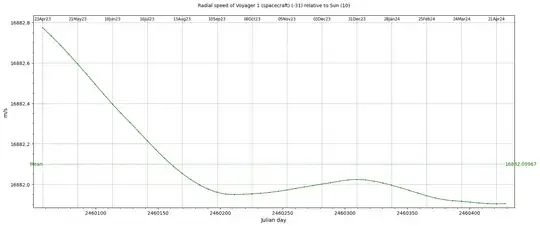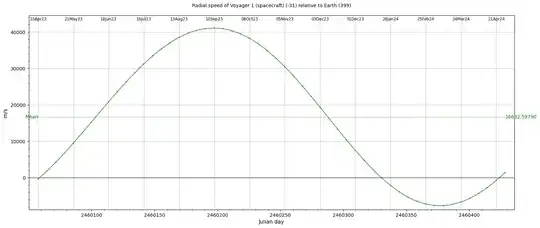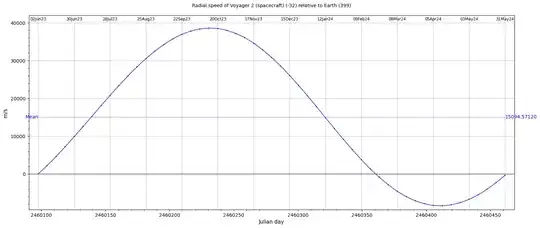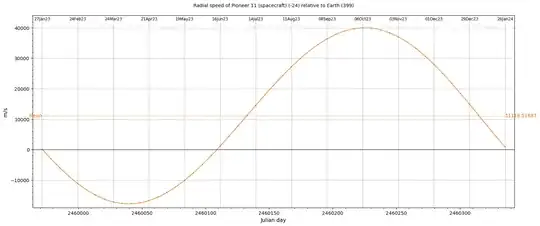According with NASA JPL the earth catches up with the spacecraft because Earth is moving a lot faster than the spacecraft. Can one calculate the times when the spacecraft gets closest to Earth
-
4Can you link the NASA JPL article? – Nilay Ghosh Feb 09 '24 at 03:14
-
It's on Twitter (X) posted today. – dimitri33 Feb 09 '24 at 04:47
-
4Also Twitter can be linked – planetmaker Feb 09 '24 at 06:59
-
There are two Voyagers, one heading north of the ecliptic, one heading south. Voyager 2 is currently travelling at ~15.032 km/s away from the Sun. – PM 2Ring Feb 09 '24 at 12:32
1 Answers
We can access trajectory data for the Voyagers via the Horizons system of JPL. For various reasons, Horizons didn't have great trajectory data for these spacecraft. However, in 2022, R. Jacobson (former Voyager navigation), was able to reconstruct these trajectories. There's some info about that in these Horizons data files:
Voyager 1
Voyager 2
The Voyagers are gradually losing speed as they climb out of the Solar System's gravity well: they're trading kinetic energy for potential energy. They have enough kinetic energy to escape our gravity well, but they will continue to lose speed over the years and centuries to come.
The current speeds of Voyager 1 and 2 relative to the Sun are roughly 17 km/s and 15 km/s, respectively. Earth's orbital speed is around 30 km/s, so there are periods each year when the Voyagers have negative speed relative to Earth.
Here are some speed graphs for Voyager 1, produced using Horizons data. The timestep is 7 days, and each data point is for 0:00 TDB, which is close to midnight UTC.
First, here's Voyager 1's speed relative to the Solar System barycentre.
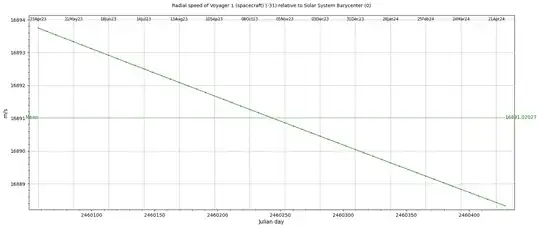
Here's its speed relative to the Sun, which looks a little wobbly, mostly because of the effects of Jupiter and the other giant planets on the Sun.
And here's its speed relative to the Earth.
And here's Voyager 2, relative to the Earth.
The last two graphs look quite similar. We can see that most of the time, the Voyagers are definitely heading away from Earth, but for almost 3 months each year, we're outpacing them.
Here's my plotting script. You can use any major body that Horizons knows for the observing center, and any major or minor body as the target. Please see the Horizons manual for further details.
If you'd like to see the Voyager trajectories in 3D, please see my answer here.
Here's a plot of the distance from Earth to both Voyagers, produced using a Horizons script from that answer. The timestep is one month.
Here are speed plots for the three other spacecraft on Solar System escape trajectories, Pioneers 10 and 11, and New Horizons. Note that "The circumstances pertaining to the regeneration of the [Pioneer] spacecraft trajectory source files [...] are not well known".
Pioneer 10 Pioneer 11
- 13,836
- 2
- 40
- 58
-
The previous version of this answer had a typo in the speed graphs & plotting script. The Y axis was labelled "km/s" instead of "m/s". Oops. – PM 2Ring Mar 08 '24 at 06:30
-
"The circumstances pertaining to the regeneration of the [Pioneer] spacecraft trajectory source files". Is this a reference to the Pioneer Anomaly? – JohnHunt Mar 08 '24 at 07:57
-
@JohnHunt No, it's just a consequence of the fact that NASA didn't save every little detail on computers 50 years ago. – PM 2Ring Mar 08 '24 at 08:01
